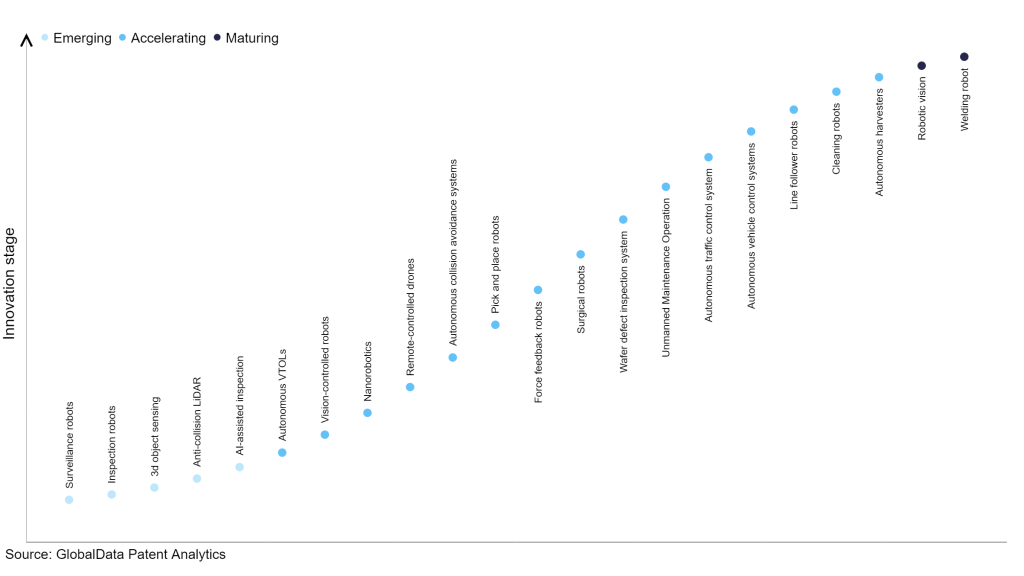The technology industry continues to be a hotbed of innovation, with activity driven by advances in robotics, sensors, machine learning (ML), and artificial intelligence (AI), and growing importance of technologies such as photogrammetry, laser scanning, X-ray, computed tomography (CT), and magnetic resonance imaging (MRI) for various applications, including product design, manufacturing, medical imaging. In the last three years alone, there have been over 3.6 million patents filed and granted in the technology industry, according to GlobalData’s report on Innovation in Robotics: 3D object sensing. Buy the report here.
However, not all innovations are equal and nor do they follow a constant upward trend. Instead, their evolution takes the form of an S-shaped curve that reflects their typical lifecycle from early emergence to accelerating adoption, before finally stabilising and reaching maturity.
Identifying where a particular innovation is on this journey, especially those that are in the emerging and accelerating stages, is essential for understanding their current level of adoption and the likely future trajectory and impact they will have.
300+ innovations will shape the technology industry
According to GlobalData’s Technology Foresights, which plots the S-curve for the technology industry using innovation intensity models built on over 2.5 million patents, there are 300+ innovation areas that will shape the future of the industry.
Within the emerging innovation stage, AI-assisted inspection, anti-collision LiDAR, and 3D object sensing are disruptive technologies that are in the early stages of application and should be tracked closely. Autonomous harvesters, cleaning robots, and line follower robots are some of the accelerating innovation areas, where adoption has been steadily increasing. Among maturing innovation areas, welding robot, and robotic vision are now well established in the industry.
Innovation S-curve for robotics in the technology industry

3D object sensing is a key innovation area in robotics
3D object sensing involves detecting, analysing, and measuring three-dimensional objects using sensors and algorithms. This technology finds its application in various fields such as robotics, augmented reality, and 3D printing.
GlobalData’s analysis also uncovers the companies at the forefront of each innovation area and assesses the potential reach and impact of their patenting activity across different applications and geographies. According to GlobalData, there are 90+ companies, spanning technology vendors, established technology companies, and up-and-coming start-ups engaged in the development and application of 3D object sensing.
Key players in 3D object sensing – a disruptive innovation in the technology industry
‘Application diversity’ measures the number of different applications identified for each relevant patent and broadly splits companies into either ‘niche’ or ‘diversified’ innovators.
‘Geographic reach’ refers to the number of different countries each relevant patent is registered in and reflects the breadth of geographic application intended, ranging from ‘global’ to ‘local’.
Patent volumes related to 3D object sensing
Source: GlobalData Patent Analytics
Among the companies innovating in 3D object sensing, Intel is the leading. The company’s patents are focused on developing a system involving a processor that can determine the location of a landmark for autonomous vehicle navigation. The measured position and at least one previous position of the landmark are used to refine its position. The system acquires an environmental image, identifies the landmark, determines its relative position to the host vehicle, and uses GPS data to determine its globally localised position.
Other prominent patent filers in the 3D object sensing space include Alphabet and Walmart.
By geographic reach, Faurecia leads the pack, followed by Halliburton and Corteva. In terms of application diversity, May Mobility holds the top position, followed by Halliburton and Saudi Arabian Oil Company (Saudi Aramco).
3D object sensing plays a crucial role in robotics, autonomous vehicles, augmented reality, and virtual reality. It enables robots to better navigate and manipulate objects, vehicles to detect obstacles for safer driving, and AR/VR to create realistic and immersive experiences.
To further understand how robotics is disrupting the technology industry, access GlobalData’s latest thematic research report on Robotics – Thematic Research Report.
Data Insights
From

The gold standard of business intelligence.
Blending expert knowledge with cutting-edge technology, GlobalData’s unrivalled proprietary data will enable you to decode what’s happening in your market. You can make better informed decisions and gain a future-proof advantage over your competitors.







